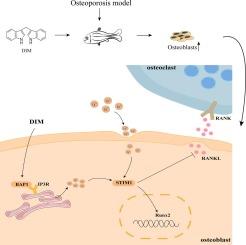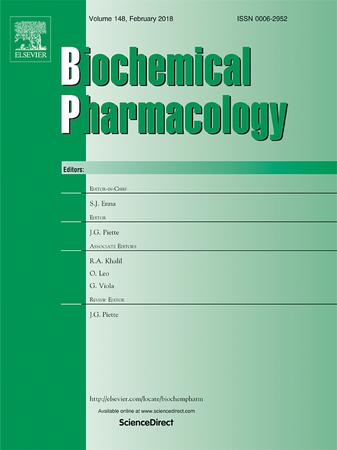3,3′-Diindolylmethane promotes bone formation – A assessment in MC3T3-E1 cells and zebrafish
IF 5.3
2区 医学
Q1 PHARMACOLOGY & PHARMACY
引用次数: 0
Abstract
Osteoporosis is a common degenerative bone disease in middle-aged and elderly people. The current drugs used to treat osteoporosis have many side effects and low patient compliance. Phytochemotherapy may be safer and more effective. 3,3′-diindolemethane (DIM) is the digestive product of indole-3-methanol in cruciferous vegetables in the stomach, which is a kind of anti-tumor and anti-oxidation phytochemical. However, the effects of DIM on osteoblasts and the mechanism by which DIM regulates bone formation are not fully understood. The aim of this study was to investigate the effects of DIM on the bone formation of mouse preosteoblasts MC3T3-E1 and zebrafish. DIM promotes proliferation and osteogenic differentiation of MC3T3-E1 cells in vitro, and also plays a bone promoting role by increasing the interaction between BRCA1-Associated Protein 1(BAP1) and Inositol 1,4,5-Trisphosphate Receptor(IP3R), up-regulating the expression of BAP1 and IP3R and downstream storage operation calcium entry (SOCE) related protein Recombinant Stromal Interaction Molecule 1(STIM1). The effect of DIM on osteoporosis was confirmed in zebrafish osteoporosis model, and its molecular mechanism may be related to BAP1/IP3R/SOCE signaling pathway. These findings highlight the potential therapeutic value of DIM in the prevention and treatment of osteoporosis.

3,3'-二吲哚甲烷促进骨形成--在 MC3T3-E1 细胞和斑马鱼中进行的评估
骨质疏松症是中老年人常见的退行性骨病。目前用于治疗骨质疏松症的药物副作用大,患者依从性低。植物化学疗法可能更安全、更有效。3,3'-二吲哚甲烷(DIM)是十字花科蔬菜中的吲哚-3-甲醇在胃中的消化产物,是一种抗肿瘤、抗氧化的植物化学物质。然而,DIM 对成骨细胞的影响以及 DIM 调节骨形成的机制尚未完全清楚。本研究旨在探讨 DIM 对小鼠前成骨细胞 MC3T3-E1 和斑马鱼骨形成的影响。DIM能促进体外MC3T3-E1细胞的增殖和成骨分化,还能通过增加BRCA1相关蛋白1(BAP1)和1,4,5-三磷酸肌醇受体(IP3R)之间的相互作用、上调BAP1和IP3R以及下游贮存操作钙离子进入(SOCE)相关蛋白重组基质相互作用分子1(STIM1)的表达,发挥促骨作用。在斑马鱼骨质疏松症模型中证实了 DIM 对骨质疏松症的影响,其分子机制可能与 BAP1/IP3R/SOCE 信号通路有关。这些发现凸显了 DIM 在预防和治疗骨质疏松症方面的潜在治疗价值。
本文章由计算机程序翻译,如有差异,请以英文原文为准。
求助全文
约1分钟内获得全文
求助全文
来源期刊

Biochemical pharmacology
医学-药学
CiteScore
10.30
自引率
1.70%
发文量
420
审稿时长
17 days
期刊介绍:
Biochemical Pharmacology publishes original research findings, Commentaries and review articles related to the elucidation of cellular and tissue function(s) at the biochemical and molecular levels, the modification of cellular phenotype(s) by genetic, transcriptional/translational or drug/compound-induced modifications, as well as the pharmacodynamics and pharmacokinetics of xenobiotics and drugs, the latter including both small molecules and biologics.
The journal''s target audience includes scientists engaged in the identification and study of the mechanisms of action of xenobiotics, biologics and drugs and in the drug discovery and development process.
All areas of cellular biology and cellular, tissue/organ and whole animal pharmacology fall within the scope of the journal. Drug classes covered include anti-infectives, anti-inflammatory agents, chemotherapeutics, cardiovascular, endocrinological, immunological, metabolic, neurological and psychiatric drugs, as well as research on drug metabolism and kinetics. While medicinal chemistry is a topic of complimentary interest, manuscripts in this area must contain sufficient biological data to characterize pharmacologically the compounds reported. Submissions describing work focused predominately on chemical synthesis and molecular modeling will not be considered for review.
While particular emphasis is placed on reporting the results of molecular and biochemical studies, research involving the use of tissue and animal models of human pathophysiology and toxicology is of interest to the extent that it helps define drug mechanisms of action, safety and efficacy.
文献相关原料
公司名称
产品信息
上海源叶
prednisolone
 求助内容:
求助内容: 应助结果提醒方式:
应助结果提醒方式:


